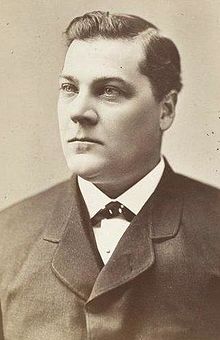Get Today in Masonic History into your Inbox. Sign up today for one of our email lists!
Need an article for your Trestleboard/Newsletter see our Use Policy
Henry Honychurch Gorringe Passes Away

Today in Masonic History Henry Honychurch Gorringe passes away in 1885.
Henry Honychurch Gorringe was an American naval officer and explorer.
Gorringe was born on August 11th, 1841 in the British Colony of Barbados. At a young age he moved to the United States and entered the merchant marine.
In 1862, Gorringe enlisted in Union Navy during the American Civil War. He worked his way up from Mate to Active Volunteer Lieutenant Commander by the end of the war. After the war, he decided to stay in the United States Navy and was given a commission as a lieutenant in 1868. By the end of the year he had been promoted to lieutenant commander.
During his time in the Navy, Gorringe discovered an underwater mountain range which is now named Gorringe Sea Bank in 1875. He also compiled a book on the exploration of the Río de la Plata, the river and estuary (a partially enclosed area where the fresh water of a river and the sea water of the ocean combine) form by the confluence of the Uruguay and the Paraná rivers. The book was published by the U.S. Hydrographic Office.
In 1877, the United States received as a gift an obelisk originally erected in Egypt by Thutmosis III. The United States was responsible for transporting the obelisk from Egypt and it was opened up for bid. In 1879, the bid Gorringe put forth was accepted, largely because it was the only one providing a complete plan of how to move the obelisk from Egypt into Central Park in New York. To accomplish this feat first Gorringe had to dig out the obelisk by removing 1,730 cubic yards of earth. Using a rigging of his own design he was then able to lay the obelisk down and prepare it for loading on to a ship. The ship, the Dessoug an Egyptian ship he purchased, had a hole cut in one end of it, allowing him to load the 69 feet long obelisk into the hold of the ship.
Once the obelisk arrived in New York City, a special train system was constructed for moving it into it's final position in Central Park.
The obelisk is one of three, the other two are in London and Paris, which are referred to as Cleopatra's Needle. It is claimed at the bottom of the obelisk there are masonic symbols.
Gorringe wrote a book Egyptian Obelisks about the one he moved as well as the other two in Paris and London. In 1883, he began to publicly criticize naval affairs and then resigned from the Navy.
Gorringe passed away on July 7th, 1885 due to an accident when he jumped from a moving train.
He was a member of Anglo-Saxon Lodge No. 137 in New York City, New York.
This article provided by Brother Eric C. Steele.
| S | M | T | W | T | F | S |
| 1 | 2 | |||||
| 3 | 4 | 5 | 6 | 7 | 8 | 9 |
| 10 | 11 | 12 | 13 | 14 | 15 | 16 |
| 17 | 18 | 19 | 20 | 21 | 22 | 23 |
| 24 | 25 | 26 | 27 | 28 | 29 | 30 |
| 31 | ||||||
Other Events Today
Richard Brinsley Butler Sheridan Passes Away
Sir Arthur Ignatius Conan Doyle Passes Away
Samuel Blatchford Passes Away
Oliver Russell, 2nd Baron Ampthill is Born

